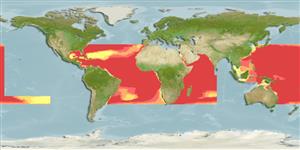>
Stomiiformes (Lightfishes and dragonfishes) >
Stomiidae (Barbeled dragonfishes) > Melanostomiinae
Etymology: Photonectes: Greek, photos = light + Greek, nekton = swimmer (Ref. 45335).
Environment: milieu / climate zone / depth range / distribution range
Écologie
marin. Subtropical; 37°N - 35°S
Eastern Atlantic: Western Sahara to Mauritania. Western Atlantic: 37°N to 23°N west of 35°W, one record at 2°N, and from Brazil to Argentina. Western Central Pacific: Australia (Ref. 7300) and Papua New Guinea (Ref. 6993).
Taille / Poids / Âge
Maturity: Lm ? range ? - ? cm
Max length : 16.4 cm SL mâle / non sexé; (Ref. 4468)
Description synthétique
Morphologie | Morphométrie
Rayons mous dorsaux (Total): 16-17; Rayons mous anaux: 18 - 20. This species is distinguished by the following characters: elongated body tapering toward caudal fin; snout 1.25 times shorter than eye; morphometric values (IOM specimen only), in % of SL: head length 15.7; snout length 2.4; eye diameter 3.0; least interorbital width 4.0; barbel length 10.8; upper jaw length 13.3; postorbital organ length 3.0; ditto, greatest depth 0.9, entire black surrounding area 4.2; predorsal, preanal and prepelvic distances 78.3, 78.3 and 66.3, respectively; dorsal- and anal-fin base length 12.7 and 13.9, respectively; pelvic-fin length 12.1; greatest body depth 12.1; least depth of caudal peduncle 2.4; the opercle almost straight dorsally, with posteroventral corner somewhat extended, rounded; gill filaments extending slightly beyond gill cover; gill filaments shortened in upper half of ceratobranchial of first arch (twice shorter than lowermost filaments of ceratobranchial-1). Color of skin turns to rusty brown after more than 40 years of storage (Ref. 120405).
Mesopelagic species (Ref. 75154).
Life cycle and mating behavior
Maturité | Reproduction | Frai | Œufs | Fécondité | Larves
Prokofiev, A.M. and C. Klepadlo, 2019. Two new species of Photonectes with blue luminous tissue on body, and a re-examination of P. mirabilis (Teleostei: Stomiidae). Zootaxa 4590(2):270-282. (Ref. 120405)
Statut dans la liste rouge de l'IUCN (Ref. 130435)
Menace pour l'homme
Harmless
Utilisations par l'homme
Plus d'informations
Noms communsSynonymesMétabolismePrédateursÉcotoxicologieReproductionMaturitéFraiRassemblement de ponteFéconditéŒufsDéveloppement de l'œuf
Taille/ÂgeCroissanceLongueur-poidsLongueur-longueurFréquences de longueursMorphométrieMorphologieLarvesDynamique des populations larvairesRecrutementAbondanceBRUVS
RéférencesAquacultureProfil d'aquacultureSouchesGénétiqueElectrophoresesHéritabilitéPathologiesTraitementNutrientsMass conversion
CollaborateursImagesStamps, Coins Misc.SonsCiguateraVitesseType de nageSurface branchialeOtolithesCerveauxVision
Outils
Articles particuliers
Télécharger en XML
Sources Internet
Estimates based on models
Preferred temperature (Ref.
123201): 9.1 - 19.4, mean 13.8 °C (based on 605 cells).
Phylogenetic diversity index (Ref.
82804): PD
50 = 0.5000 [Uniqueness, from 0.5 = low to 2.0 = high].
Bayesian length-weight: a=0.00302 (0.00117 - 0.00783), b=3.12 (2.89 - 3.35), in cm total length, based on LWR estimates for this (Sub)family-body shape (Ref.
93245).
Niveau trophique (Ref.
69278): 3.9 ±0.7 se; based on size and trophs of closest relatives
Résilience (Ref.
120179): Haut, temps minimum de doublement de population inférieur à 15 mois (Preliminary K or Fecundity.).
Fishing Vulnerability (Ref.
59153): Low vulnerability (10 of 100).
